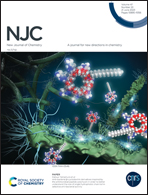A quaternized anthraquinone derivative for pH-neutral aqueous organic redox flow batteries†
Abstract
A pH-neutral aqueous organic redox flow battery (AORFB) is one of the most attractive redox flow battery systems due to its non-corrosivity and low-cost as well as a wider electrochemical stability potential window than the acidic and alkaline electrolytes. Herein, by incorporating two quaternary ammonium groups into an anthraquinone nucleus, a water-soluble redox-active molecule, 2,2′-((9,10-dioxo-9,10-dihydroanthracene-1,4-diyl)bis(azanediyl))bis(N,N,N-trimethylethan-1-aminium)dichloride (BDEAQCl2), was achieved that could serve as an anolyte material in pH-neutral AORFBs. The BDEAQCl2 displays a highly negative redox-potential of −0.554 V (vs. SHE) in pH-neutral aqueous electrolytes, rapid electrochemical kinetics and high aqueous-solubility (∼1.2 M in H2O) as well as low permeability. The pH-neutral AORFB with BDEAQCl2 as the anolyte and potassium ferrocyanide as the catholyte yields open-circuit voltage approaching ∼1.04 V. Long-term charge–discharge cycling measurements were conducted to determine the efficiency, capacity, and chemical stability of BDEAQCl2. Post-analysis indicates that BDEAQCl2 undergoes a hydrolytic side reaction during charge–discharge cycling, which is mainly responsible for capacity degradation.



 Please wait while we load your content...
Please wait while we load your content...